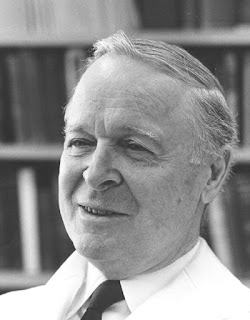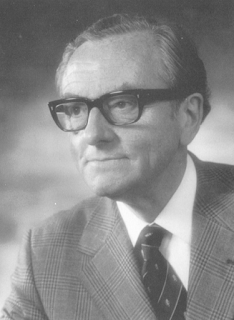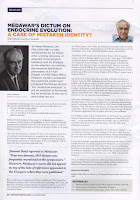A shorter version of this article recently appeared in The Endocrinologist (Autumn 2016, issue 121, page 34)(Society for Endocrinology).
I seemed to have fallen into a trap of ascribing P.B. Medawar’s famous dictum, ‘For “endocrine evolution” is not an evolution of hormones but an evolution of the use to which they are put”, to a realisation by Medawar himself. I used the quotation* from Medawar in one of my Raine Lectures at the University of Western Australia in 1998. Afterwards, Don Bradshaw pointed out that some thought the original concept seemed to have come from Frederick Lee Hisaw (1891-1972), best known perhaps for his discovery of relaxin.
 |
| Sir Peter Medawar in 1985 From Biographical Memoirs of the Royal Society |
When I got back from Australia, I looked at as many of Hisaw’s papers as I could find which were published before the Medawar dictum appeared in print. I found nothing to indicate that Hisaw had published anything that even came close to Medawar’s statement on ‘endocrine evolution’. Having other pressing things to do, I left the problem sitting at the back of my mind but only recently, have I tried again to find why the dictum is ascribed to Medawar and Hisaw—sometimes just to Hisaw. In so doing I think I may have discovered the cause of the confusion.
I was not the only one to fall into the apparent trap. Ian Chester Jones (1916-96) the leading but ultimately under-rewarded driver of comparative endocrinology in the UK, first in Liverpool and then in Sheffield, in his 1975 Dale Lecture to the Society for Endocrinology (published in 1976) wrote, after quoting the dictum:
Geschwind (1967) found some value in the dictum which he quoted without reference. Perhaps rightly so, as it is in a sense, part of the folklore of endocrinology. In a discussion at the 3rd International Symposium of Comparative Endocrinology in 1961 at Oiso, Japan, I declared the aphorism and with some degree of national pride. However, I ran into trouble as Carol [sic†] Williams said Medawar must have picked it up at Harvard as it tripped lightly off Fred Hisaw’s tongue many a long year before. Whereupon it turned out that Emil Witschi conceived it in Switzerland and brought it to his classes in Iowa City.
 |
| F.L. Hisaw From the Endocrine Society |
Neither I nor Chester Jones should have failed to notice a reference in this context to Hisaw in Aubrey Gorbman and Howard Bern’s A Textbook of Comparative Endocrinology published in 1961 (Wiley, New York):
The generalization that “it is not hormones which have evolved but the uses to which they are put—ascribed to Medawar and to Hisaw—is fundamental to much of the discussion of hormonal mechanisms in the literature.”
Ironically, that then new book was the one recommended by Chester Jones to accompany the lecture course in comparative endocrinology for first year zoology students at Sheffield in 1962. It cost 94 shillings, the equivalent of £90 today, and made a severe dent in my finances.
Medawar’s dictum appeared in his chapter, ‘Some immunological and endocrinological problems raised by the evolution of viviparity on vertebrates’ published in Symposia of the Society for Experimental Biology (volume 7, 1953). It was an account of a symposium, Evolution, held with the Genetical Society at Oxford in July 1952.
Reading the 1953 paper in full, it is evident that Medawar built his argument as he considered the role of the endocrine system in the evolution of viviparity and the immunological problem brought about by gestation. Thus, earlier in the chapter, in discussing prolactin, Medawar wrote:
Not even the possession of’ prolactin’, then can be said to be distinctive of mammals; what is distinctive of mammals is the evolution of a new mode of tissue response to hormones of a category already in being. In discussing the comparative endocrinology of the adrenal gland it will be urged that this is a generally applicable rule.
Tracking who said what and when on ‘endocrine evolution’ has been greatly facilitated by the appearance of previously unpublished letters. The Wellcome Library has digitised Sir Peter Medawar’s (1915-1987) correspondence. It is now quite clear Medawar’s dictum was an original thought, or, at least, an independent one. Five years after it appeared in print, we find him, on 26 September 1958, writing to Hisaw at Harvard:
My imagination was very much stirred by the reference in Nature of September 20th to your contribution to the comparative endocrinology symposium at Cold Spring Harbor. I am giving a lecture early next year in which I want to go into one or two problems about the evolution of he endocrine system, and it would be of the utmost value to me to be able to refer to the conception you delivered at the conference. Do you by any chance have a spare copy, for loan or for keeps, of your manuscript? I ask because I have no confidence at all that the proceedings of the symposium will be published in time to serve my particular purpose.
I wonder if you remember that we met about 10 years ago at Harvard. when I was delivering the Prather Lectures [1949, a series of six lectures ‘Studies on Growth, Individuality and Ageing’] - a visit which I shall always remember with the utmost pleasure.
Hisaw replied warmly on 6 October to the effect that he had only three typed copies of his manuscript; one had gone to the editor; a second to a friend who was writing a book and the third to “Dr J.M. Dodd who presided at the meeting…For you he is rather close by and it may be more convenient to get his copy than for me to try to recover one that I have given away over here”.
 |
| J.M. Dodd in 1975 From Biographical Memoirs of the Royal Society |
Medawar then wrote to Dodd (James Munro Dodd FRS (1915-86), then at St Andrews but soon to be Professor of Zoology at Leeds) to ask him to see his copy; there is however, a curious ending: ‘It would be extremely valuable to me if I could take a glance at it, if it is really true that you have got it’. Jimmie Dodd replied on 28 October:
I have had a copy of Hisaw’s paper made for you; please keep it. I find it a very stimulating presentation, but it contains rather many “ifs” for my liking. Unfortunately, when Hisaw gave the paper at Cold Spring Harbor, there was no time for discussion. Had there been, I am sure some tricky questions would have been asked: I had some myself!
Your now famous 1953 dictum was frequently mentioned at the symposium, and it interests me very much. I would welcome an opportunity of discussing it with you sometime. I am sure you will lose no sleep over the fact that I tend to disagree with it…
Dodd goes on to state the grounds on which he disagrees with the dictum but that extends the present discussion too far for the present article.
Medawar wrote back two days later to thank him for sending a copy of Hisaw’s paper, and continued:
The reason why I am getting fussed about endocrinology is that I am giving the Waynflete Lectures in Magdelen and want to devote one of them to “Some Problems of the Evolution of Endocrine Systems” - the subject of my impertinent generalisation of 1953 - is only one of the problems, though probably the most important one…
The manuscripts Medawar was so keen to acquire (he obtained a copy of E.J.W. Barrington’s paper given at the same meeting) were from a Columbia University symposium which was held at Cold Spring Harbor, New York, on May 25 to 29, 1958. The proceedings were edited by Aubrey Gorbman, and published as Comparative Endocrinology by Wiley in 1959.
It is in Hisaw’s paper, Endocrine adaptations of the mammalian estrous cycle and gestation’, that the basis for the confusion between Medawar and Hisaw lies. The paper (pages 533-552) ends:
…to the generalization which states in effect that it is not hormones which have evolved but the uses to which they are put. Note the italics (in bold italics here). The wording (Medawar's was, for comparison, For “endocrine evolution” is not an evolution of hormones but an evolution of the use to which they are put) is almost pure Medawar. But Hisaw does not make reference to Medawar!
It is not then, perhaps, surprising that those following took Hisaw’s words, in italics but in fact an inaccurate quotation, to indicate that he, Hisaw, had come up with the idea rather than, or as well as, Medawar.
Is is also of interest to note that while Jimmie Dodd reported to Medawar (see above), ‘Your now famous 1953 dictum was frequently mentioned at the symposium’, Medawar’s name did not appear in any of the lists of references appended to the 43 papers.
Attribution of the Medawar dictum to Hisaw can be found. For example, Sawyer, Munsick and van Dyke in their paper, Antidiuretic hormones, published in 1960 (Circulation 21, 1027-1037) wrote:
F.L.Hisaw recently restated his generalization that, "It is not hormones which have evolved but the uses to which they are put."
The reference for the statement was to Hisaw’s paper at the Cold Spring Harbor Symposium, and as I noted, I have not been able to find an original generalization to restate. It should be noted that Sawyer’s name appears in the list of those who attended the Symposium.
Attribution to Hisaw rather than to Medawar appears more recently, in Wingfield’s chapter, Communicative behaviors, hormone-behavior interactions, and reproduction in vertebrates, in the third edition of Knobil and Neill’s Physiology of Reproduction, Elsevier, 2006): F. Hisaw put this very aptly some years: “it is not the hormones that have evolved, but the uses to which they are put.”
But then comes the rub. Hisaw in paraphrasing and almost quoting Medawar word for word, was actually disagreeing with the concept. The last sentence of Hisaw’s chapter is worth quoting in full:
Our limited knowledge is such that it is highly probable that many additional placental adaptations remain to be discovered, but from what is known it also appears that in the evolution of viviparity the acquiring of endocrine function by the placenta furnishes notable exceptions to the generalization which states in effect that it is not hormones which have evolved but the uses to which they are put.
Perhaps this disagreement is the reason Medawar was perhaps just a little sniffy about Hisaw’s paper in his letter to Jimmie Dodd of 5 November 1958. They were arranging to discuss Dodd’s reservations about the dictum and Medawar first invited Dodd to his party on 18 December during the meeting of the Society for Experimental Biology. He continued:
I am not terribly worried about the detailed chemical composition of the hormones of lower Vertebrates, for, after all, there is a certain latitude of chemical composition even in mammalian hormones - e.g. the essentially similar actions of cortisone, cortisol, and the hadcortisols [sic], the variety of oestrogenic substances, the action of adrenalin and noradrenalin etc. etc. But differences of biological specificity between apparently homologous hormones are of course very important indeed. I note that Hisaw trots out a number of examples when discussing the differences between placental, pituitary and ovarian hormones. This is just the kind of thing I ought to know about and look forward to discussing…
Turning to Chester Jones’s talk in Japan in 1961, I have no doubt that Hisaw did use the dictum around Harvard, as Williams pointed out. Unfortunately, I have been unable to find a Biographical Memoir for the National Academy of Sciences (he was elected in 1947) but Hisaw’s obituary, published in Endocrinology (93, 273-276) notes:
Hisaw developed the idea that during evolution hormones had been "captured" to serve different purposes. Finding mammalian type estrogens in such animals as clams, starfish, and sea urchins it was his thought that these substances originally served only the purpose of stimulating growth of the ovum and that the mammals had taken them over for other purposes.
Publication lists suggest that these ideas were ‘developed’ during the 1960s‡, i.e. ten years after Medawar’s publication.
I have found no other correspondence between Medawar and Hisaw on ‘endocrine evolution’ but it is clear that they met after 1949. Hisaw wrote to Medawar in 1965 a few days after their meeting to congratulate him on his election as a Foreign Associate of the National Academy of Sciences; he also reminds Medawar of the offer of a job that Harvard made after the Prather Lectures referred to above and concludes, ‘It should be said that subsequent developments have proven your wise judgement in such matters’.
I do not know when or how Emil Witschi (1890-1971), who moved to Iowa from Switzerland in 1927, was believed to have developed or expounded the same general idea; I suspect Chester Jones didn’t either. However, it should be noted that Witschi was also a contributor to the 1958 symposium at Cold Spring Harbor.
But then I find another player had entered the frame and one that I should have known about since conversations I had with Amo (I find it difficult to write Professor E.C. Amoroso FRS in full) over ten years touched on pretty well everything else under the sun. I was surprised to discover that he wrote the following:
‘It is certainly true that a plausible picture of the evolution of the endocrines based on established facts is a necessity for any adequate understanding of the system. But while waiting for such a picture to become available, it may be well to bear in mind that it is the tissues and not the hormones that really do the “reacting”. The expression “action of hormones” is to some extent figurative.’ The words are not my own, but were written by Danforth nearly a quarter of a century ago, and long before the much quoted generalization ascribed to Medaway and Hisaw…
The quotation is from the published version of Amo’s Inaugural Lecture on Present Perspectives in Endocrinology given at a NATO Advanced Study Institute, Techniques in Endocrine Research, which was held at Stratford-upon-Avon in September 1962. The proceedings were edited by Peter Eckstein and Francis Knowles and published by Academic Press in 1963.
 |
| C.H. Danforth From Biographical Memoirs of the National Academy of Sciences |
The idea that Charles Haskell Danforth (1883-1969) was the originator of the concept was repeated in the chapter, Ovarian activity during gestation (page 362) that Amo and John Perry wrote just yards from my lab for the second edition of Zuckerman’s multi-author book, The Ovary (Volume 2: Physiology) which was edited by Zuckerman and Barbara Weir. That book eventually appeared in 1977 after the chapters had been written in the early 1970s; the authors, incidentally, blamed Zuckerman for the the delay. In that chapter, a reference to Danforth was included: Danforth, C.H. (1939) Relation of genic and endocrine factors in sex. In: Sex and Internal Secretions, 2d ed., ed. by Edgar Allen, C. H. Danforth, and E. A. Doisy, pp. 328-50. Baltimore, Williams & Wilkins Company. I have not yet read that paper but C.H. Danforth’s biographical memoir for the U.S. National Academy of Sciences states:
As to the site of hormonal action, Danforth had little to say, save that hormones act as "activators or stimulators" and "produce their final effect only through such protoplasm as will respond to them." Moreover, the specificity of most hormone-tissue reactions is more properly an attribute of the tissue than of the hormone—it is largely a question of whether or not the tissue will utilize the hormone if available.
My impression is that Danforth was concerned more with the control of events within the tissues of an organism rather than the with timescale of evolution of the vertebrates, in other words, about proximate rather than ultimate causation (to use those maligned but still useful terms).
Incidentally, Medawar thanked both Amo and Chester Jones for help in preparing his 1952/53 paper; the letter from Chester Jones on the adrenal cortex is in the Medawar papers. From what I have read I cannot think he discussed his conclusion on ‘endocrine evolution’ with either of them before he committed it to print.
I hope this note sheds light on the origin of what Chester Jones described in his Dale Lecture as part of the folklore of endocrinology. However, it must be seen as a work in progress since there may be papers, records or recollections of meetings and other material I have not seen that may shed more light on the matter.
For the moment though there seems little doubt that the dictum firmly belongs to Medawar. Chester Jones’s ‘national pride’ may not after all have been dashed in Japan in 1961.
------------------------------
*The full sentence is: ‘For “endocrine evolution” is not an evolution of hormones but an evolution of the use to which they are put; an evolution not, to put it crudely, of chemical formulae but of reactivities, reaction patterns and tissue competences’. Medawar, P.B. 1953. Some immunological and endocrinological problems raised by the evolution of viviparity in vertebrates. Symposia of the Society for Experimental Biology 7, 320-338.
†Carroll Milton Williams (1916-1991), insect endocrinologist

No comments:
Post a Comment